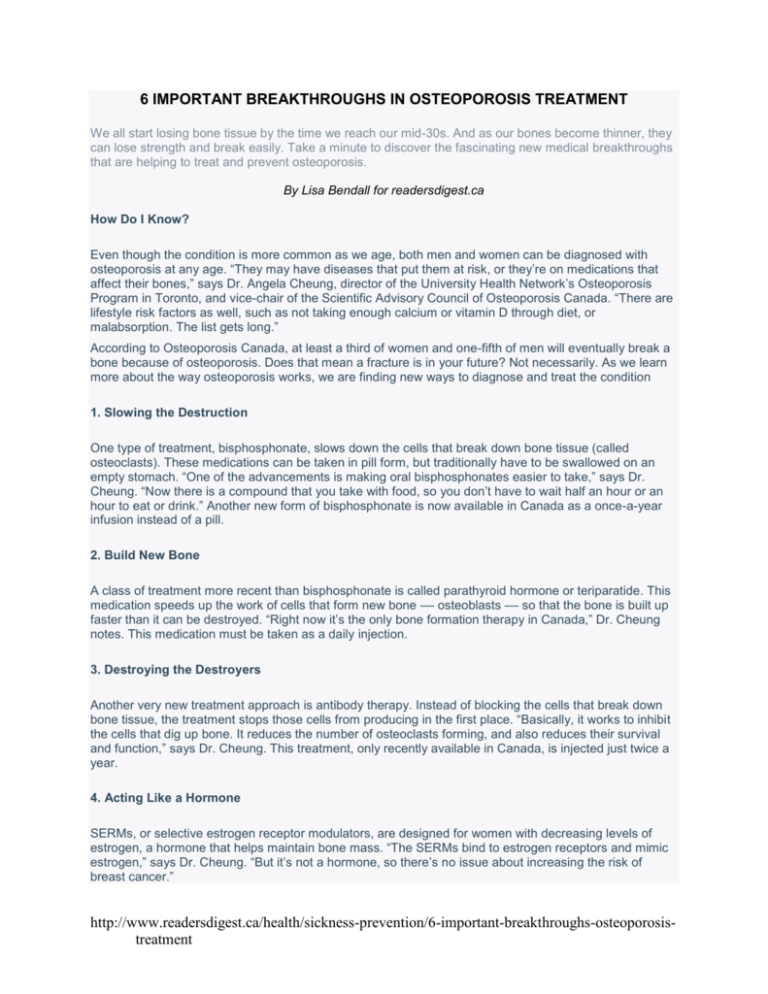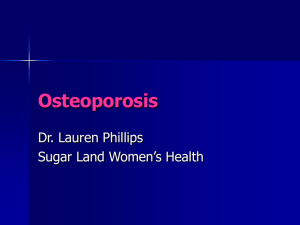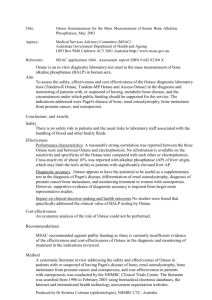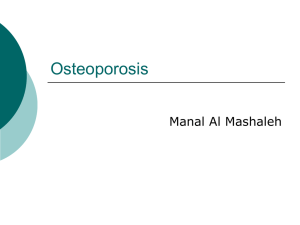6 Important Breakthroughs in Osteoporosis Treatment
advertisement

6 IMPORTANT BREAKTHROUGHS IN OSTEOPOROSIS TREATMENT We all start losing bone tissue by the time we reach our mid-30s. And as our bones become thinner, they can lose strength and break easily. Take a minute to discover the fascinating new medical breakthroughs that are helping to treat and prevent osteoporosis. By Lisa Bendall for readersdigest.ca How Do I Know? Even though the condition is more common as we age, both men and women can be diagnosed with osteoporosis at any age. “They may have diseases that put them at risk, or they’re on medications that affect their bones,” says Dr. Angela Cheung, director of the University Health Network’s Osteoporosis Program in Toronto, and vice-chair of the Scientific Advisory Council of Osteoporosis Canada. “There are lifestyle risk factors as well, such as not taking enough calcium or vitamin D through diet, or malabsorption. The list gets long.” According to Osteoporosis Canada, at least a third of women and one-fifth of men will eventually break a bone because of osteoporosis. Does that mean a fracture is in your future? Not necessarily. As we learn more about the way osteoporosis works, we are finding new ways to diagnose and treat the condition 1. Slowing the Destruction One type of treatment, bisphosphonate, slows down the cells that break down bone tissue (called osteoclasts). These medications can be taken in pill form, but traditionally have to be swallowed on an empty stomach. “One of the advancements is making oral bisphosphonates easier to take,” says Dr. Cheung. “Now there is a compound that you take with food, so you don’t have to wait half an hour or an hour to eat or drink.” Another new form of bisphosphonate is now available in Canada as a once-a-year infusion instead of a pill. 2. Build New Bone A class of treatment more recent than bisphosphonate is called parathyroid hormone or teriparatide. This medication speeds up the work of cells that form new bone –– osteoblasts –– so that the bone is built up faster than it can be destroyed. “Right now it’s the only bone formation therapy in Canada,” Dr. Cheung notes. This medication must be taken as a daily injection. 3. Destroying the Destroyers Another very new treatment approach is antibody therapy. Instead of blocking the cells that break down bone tissue, the treatment stops those cells from producing in the first place. “Basically, it works to inhibit the cells that dig up bone. It reduces the number of osteoclasts forming, and also reduces their survival and function,” says Dr. Cheung. This treatment, only recently available in Canada, is injected just twice a year. 4. Acting Like a Hormone SERMs, or selective estrogen receptor modulators, are designed for women with decreasing levels of estrogen, a hormone that helps maintain bone mass. “The SERMs bind to estrogen receptors and mimic estrogen,” says Dr. Cheung. “But it’s not a hormone, so there’s no issue about increasing the risk of breast cancer.” http://www.readersdigest.ca/health/sickness-prevention/6-important-breakthroughs-osteoporosistreatment 5. What's Next? Currently, clinical trials around the world are using a medication to inhibit cathepsin K, an enzyme that digests bone. “They’re looking to see if it protects against fractures,” says Dr. Cheung. “We’re all waiting for the results.” Researchers at Stony Brook University in New York are working with ultrasound to stimulate the activity of osteoblasts, hoping this can eventually lead to a treatment that regenerates bone. 6. A New Form of Early Detection Osteoporosis often goes undiagnosed until a bone is broken. An international study has identified genes associated with bone density and fractures. This could mean a blood test may one day tell you if you’re at risk for a broken bone. And at Arizona State University and NASA, scientists are working on a technique of analyzing isotopes – atoms of calcium that have different masses – instead of using X-rays, to detect bone loss at an earlier stage. Help Yourself Now Whether or not you’ve been diagnosed with osteoporosis, it’s important to do what you can to maintain bone mass. Research is ongoing in this area; two studies released this summer, for instance, promote the effects of olive oil and even moderate amounts of alcohol on healthy bone. What we know for sure is that your diet should include adequate levels of calcium and vitamin D, and your day should include physical activity, especially weight-bearing exercise. And if you do have a fracture, make sure you talk with your doctor about ways to prevent another one. “We’re trying to make their first break their last,” Dr. Cheung says. http://www.readersdigest.ca/health/sickness-prevention/6-important-breakthroughs-osteoporosistreatment








